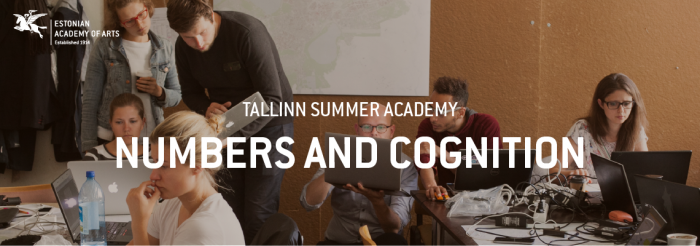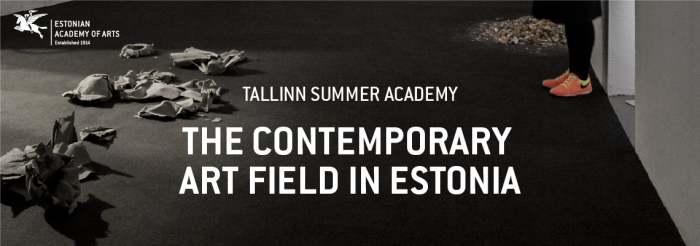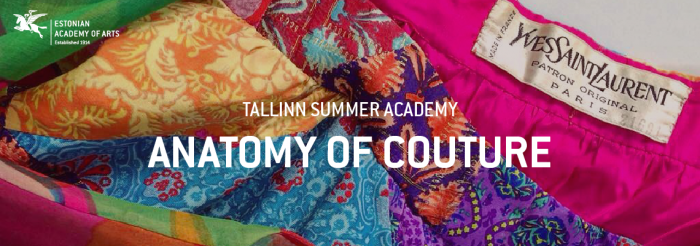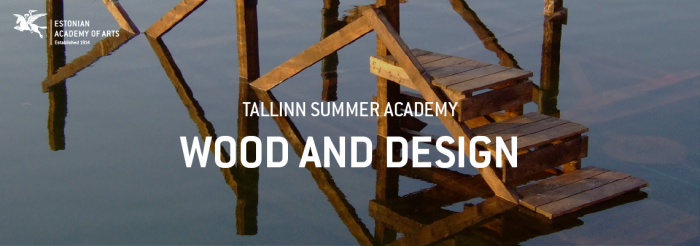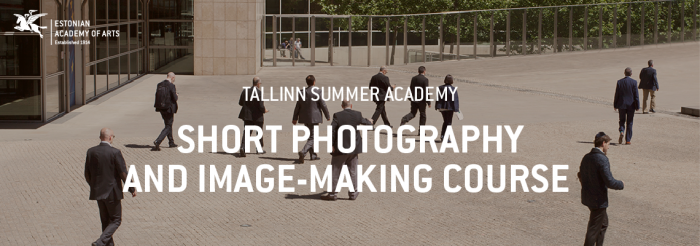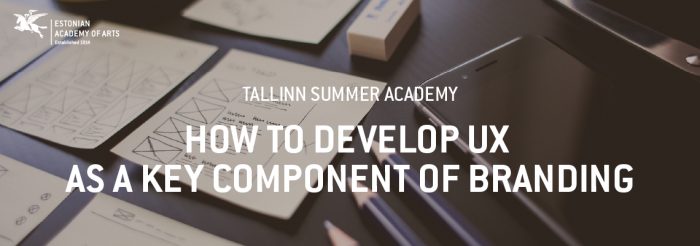Open Academy Courses
20.08.2018 — 24.08.2018
Numbers and Cognition in the Urban Environment
Dates: 20-24 August 2018
Volume: 40 hours, 3 ECTS
Location: Department of Architecture at the Estonian Academy of Arts, Pikk tn 20, Tallinn
Number of participants: max 25
Cost: FREE (Please note that this course is meant for higher education students only)
Registration deadline: 6th of May
In case of high volume of applications, prospective participants are asked to write an essay one A4-format page in length (approximately 250 words).
Content of the course
This workshop is structured on architecture, numbers and cognition with the focus mainly on public space. Two broader topics pervade the workshop. One of them is more physical, involving translating the world into parameters, and the other is mapping social activities. The broad goal is to find connections between the two sets of topics. The environment around us consists of a number of physically countable and measurable parameters, which we can use to describe it (width of a carriageway, location of a cafe). Which parameters are the best for describing or designing the world? As another important topic, we will map the movements or activities of human masses, using photo and image analysis and Wi-Fi positioning to this end. When, why and where are people moving and how long do they stop – this is an important set of topics, because the quality of space is largely dependent on the presence of people. The participants in the summer academy course will be challenged to find relationships between the physical world and human activity. It will be important to find a means and method for measuring and documenting the environment. Cognition referred to in the course name refers to experience that can be used in future to make decisions to design and re-design space. Ideally, we envision the participants who complete the academy to be capable of imagining and perceiving the implications of 1,000 people or 100 cars passing a point.
Picking key parameters (properties) from this environment has long received attention from urbanism scholars: William H. Whyte, who attempted to trace patterns of use of public space, or Kevin Lynch, who tried to find the mental model people use to understand a city.
The late 20th century brought a rise in computing power, which has resulted in change in the accuracy and use of many calculations. In the past, it was not conceivable to calculate trajectories from one building to another manually, but it is now possible. Alongside this trend, a completely new field has arisen: various kinds of simulations. Simulations make it possible to model traffic, pedestrians or both at the same time. Gathering data has become more intensive with a focus moving from gathering qualitative data to collecting quantitative data. A large part of the summer school involves field observations, which helps instil intuition in participants as to what a given indicator means. This will also give them a clearer understanding of the computational processes and outcomes and they will be able to rationally assess the outcomes of some simulation or facts presented to them.
Participants will become well-versed in methods and means for quantitatively and qualitatively documenting the street-level space, which can in turn later be used for analysis of other places. The participant will also receive an overview of and access to software used in the framework of the workshop. At the end of the summer school, all of the data that was gathered will be made public to allow third parties to use them in their projects – for example, to plan more fluid, safer traffic conditions.
More information and link to registration form: https://www.artun.ee/summeracademy/numbers-and-cognition/
Numbers and Cognition in the Urban Environment
Monday 20 August, 2018 — Friday 24 August, 2018
Dates: 20-24 August 2018
Volume: 40 hours, 3 ECTS
Location: Department of Architecture at the Estonian Academy of Arts, Pikk tn 20, Tallinn
Number of participants: max 25
Cost: FREE (Please note that this course is meant for higher education students only)
Registration deadline: 6th of May
In case of high volume of applications, prospective participants are asked to write an essay one A4-format page in length (approximately 250 words).
Content of the course
This workshop is structured on architecture, numbers and cognition with the focus mainly on public space. Two broader topics pervade the workshop. One of them is more physical, involving translating the world into parameters, and the other is mapping social activities. The broad goal is to find connections between the two sets of topics. The environment around us consists of a number of physically countable and measurable parameters, which we can use to describe it (width of a carriageway, location of a cafe). Which parameters are the best for describing or designing the world? As another important topic, we will map the movements or activities of human masses, using photo and image analysis and Wi-Fi positioning to this end. When, why and where are people moving and how long do they stop – this is an important set of topics, because the quality of space is largely dependent on the presence of people. The participants in the summer academy course will be challenged to find relationships between the physical world and human activity. It will be important to find a means and method for measuring and documenting the environment. Cognition referred to in the course name refers to experience that can be used in future to make decisions to design and re-design space. Ideally, we envision the participants who complete the academy to be capable of imagining and perceiving the implications of 1,000 people or 100 cars passing a point.
Picking key parameters (properties) from this environment has long received attention from urbanism scholars: William H. Whyte, who attempted to trace patterns of use of public space, or Kevin Lynch, who tried to find the mental model people use to understand a city.
The late 20th century brought a rise in computing power, which has resulted in change in the accuracy and use of many calculations. In the past, it was not conceivable to calculate trajectories from one building to another manually, but it is now possible. Alongside this trend, a completely new field has arisen: various kinds of simulations. Simulations make it possible to model traffic, pedestrians or both at the same time. Gathering data has become more intensive with a focus moving from gathering qualitative data to collecting quantitative data. A large part of the summer school involves field observations, which helps instil intuition in participants as to what a given indicator means. This will also give them a clearer understanding of the computational processes and outcomes and they will be able to rationally assess the outcomes of some simulation or facts presented to them.
Participants will become well-versed in methods and means for quantitatively and qualitatively documenting the street-level space, which can in turn later be used for analysis of other places. The participant will also receive an overview of and access to software used in the framework of the workshop. At the end of the summer school, all of the data that was gathered will be made public to allow third parties to use them in their projects – for example, to plan more fluid, safer traffic conditions.
More information and link to registration form: https://www.artun.ee/summeracademy/numbers-and-cognition/
06.08.2018 — 08.08.2018
The Contemporary Art Field in Estonia
Dates: 6-8 August 2018
Location: Estonian Academy of Arts – Estonia pst 7 / Teatri väljak 1, room 440A
Volume: 24 academic hours, 1 ECTS
Number of participants: max 22
Cost: FREE (Please note that this course is meant for higher education students only)
Registration deadline: 6th of May
In addition to the general required materials, candidates are expected to submit a letter of motivation explaining why they are applying (max A4).
The Contemporary Art Field in Estonia short course is meant for international art history or curatorship students who are who are studying contemporary Estonian or Baltic art, are interested in the contemporary Estonian art world and in working with Estonian artists, curators or art historians, plan to enrol at the Estonian Academy of Arts and are looking for an overview of how the local art landscape operates. The workshop will be led by Academy of Arts teaching staff member, head of the Centre for General Theory Subjects and freelance art critic Maarin Ektermann.
The short course provides an overview of how contemporary art scene in Estonia functions – the most important organizations, the movers and shakers, the currently important and active artists from different disciplines, and the types of events being held. The causal factors behind the art scene are also explored, starting from the restoration of independence, Estonian art in the context of the regional and broader international art scene, and much more.
Topics to be discussed:
- Trends in contemporary art (social criticism, new painting, installation – architectural approach – public space, photography, graphic design, applied arts, etc.). Examples of artists and their work.
- The functioning of the art scene – who is active (what types of professions are feasible in Estonia), how are they funded (Ministry of Culture, Cultural Endowment of Estonia, creative industries, the law that requires a 1% art budget for public buildings, private capital, the art market, artists and work), general diagnostics – bottlenecks and success stories. The development of the art scene since the 1990s, illustrated by keywords.
- Central institutions and platforms (public and private capital-based). What is characteristic for, e.g. galleries, town galleries in county seats, creative industries centres, etc.? Other examples: artists’ residencies, culture factories, Tallinn Art Hall, Tartu Art Museum, Temnikova and Kasela Gallery, Centre of Contemporary Art Estonia, Artists Union.
- Formats and locations of various events. Concentration of art scene mainly in Tallinn and Tartu – what’s going on elsewhere?
More information and link to registration form: https://www.artun.ee/summeracademy/the-contemporary-art-field-in-estonia/
The Contemporary Art Field in Estonia
Monday 06 August, 2018 — Wednesday 08 August, 2018
Dates: 6-8 August 2018
Location: Estonian Academy of Arts – Estonia pst 7 / Teatri väljak 1, room 440A
Volume: 24 academic hours, 1 ECTS
Number of participants: max 22
Cost: FREE (Please note that this course is meant for higher education students only)
Registration deadline: 6th of May
In addition to the general required materials, candidates are expected to submit a letter of motivation explaining why they are applying (max A4).
The Contemporary Art Field in Estonia short course is meant for international art history or curatorship students who are who are studying contemporary Estonian or Baltic art, are interested in the contemporary Estonian art world and in working with Estonian artists, curators or art historians, plan to enrol at the Estonian Academy of Arts and are looking for an overview of how the local art landscape operates. The workshop will be led by Academy of Arts teaching staff member, head of the Centre for General Theory Subjects and freelance art critic Maarin Ektermann.
The short course provides an overview of how contemporary art scene in Estonia functions – the most important organizations, the movers and shakers, the currently important and active artists from different disciplines, and the types of events being held. The causal factors behind the art scene are also explored, starting from the restoration of independence, Estonian art in the context of the regional and broader international art scene, and much more.
Topics to be discussed:
- Trends in contemporary art (social criticism, new painting, installation – architectural approach – public space, photography, graphic design, applied arts, etc.). Examples of artists and their work.
- The functioning of the art scene – who is active (what types of professions are feasible in Estonia), how are they funded (Ministry of Culture, Cultural Endowment of Estonia, creative industries, the law that requires a 1% art budget for public buildings, private capital, the art market, artists and work), general diagnostics – bottlenecks and success stories. The development of the art scene since the 1990s, illustrated by keywords.
- Central institutions and platforms (public and private capital-based). What is characteristic for, e.g. galleries, town galleries in county seats, creative industries centres, etc.? Other examples: artists’ residencies, culture factories, Tallinn Art Hall, Tartu Art Museum, Temnikova and Kasela Gallery, Centre of Contemporary Art Estonia, Artists Union.
- Formats and locations of various events. Concentration of art scene mainly in Tallinn and Tartu – what’s going on elsewhere?
More information and link to registration form: https://www.artun.ee/summeracademy/the-contemporary-art-field-in-estonia/
06.08.2018 — 11.08.2018
The Anatomy of Couture
Dates: 6-11 August 2018
Volume: 6 days, 3 ECTS
Location: Estonian Academy of Arts
Number of participants: max 22
Cost: FREE (Please note that this course is meant for higher education students only)
Registration deadline: 6th of May
Students applying for a slot in this workshop are asked to submit a CV and cover letter describing why they wish to participate and whether they have any old article of clothing to bring with them to Estonia. The cover letter should also reveal why they are interested in restoring textiles and haute couture.
Aim of the course:
- bring a disappearing specialized manual skill to Estonia and teach it to Estonian and international students
- restore articles of clothing in the collection of some Estonian museum and thereby contribute to the preservation of an exhibit item with historical value.
Course content:
The course provides practical and theoretical knowledge of how to restore old clothing – selection of fabrics, stitches and seams, treatment of the material, how different materials age, how to care for and restore different fabrics. In the course of the workshop, students will learn about the internal structure of haute couture clothing, allowing them to later create period-specific silhouettes or re-interpretations of them – pattern solutions for textiles, materials. The course will provide knowledge and skills that can be used to get closer to the secrets of high fashion. All of the participants in the course will be able to restore a part of dresses brought in by the lecturer.
The course teaches handicraft skills that have become a rarity, something highly sought-after among professionals. ˇFewer and fewer people practise these skills in a world dominated by modern fashions. Today clothing made 40, 50, even 100 years ago are held in high regard, as they involved the use of original patterns, hand stitching, high-quality tailoring. To this point, the creation of such clothing have remained shrouded in arcane mystery – they seem easy to imitate at first glance but it is impossible to achieve the right effect without knowing what is going on “under the dress.”
The course is mainly meant for fashion design, theatre design, restoration and design students.
More information and link to registration form: https://www.artun.ee/summeracademy/the-anatomy-of-couture/
The Anatomy of Couture
Monday 06 August, 2018 — Saturday 11 August, 2018
Dates: 6-11 August 2018
Volume: 6 days, 3 ECTS
Location: Estonian Academy of Arts
Number of participants: max 22
Cost: FREE (Please note that this course is meant for higher education students only)
Registration deadline: 6th of May
Students applying for a slot in this workshop are asked to submit a CV and cover letter describing why they wish to participate and whether they have any old article of clothing to bring with them to Estonia. The cover letter should also reveal why they are interested in restoring textiles and haute couture.
Aim of the course:
- bring a disappearing specialized manual skill to Estonia and teach it to Estonian and international students
- restore articles of clothing in the collection of some Estonian museum and thereby contribute to the preservation of an exhibit item with historical value.
Course content:
The course provides practical and theoretical knowledge of how to restore old clothing – selection of fabrics, stitches and seams, treatment of the material, how different materials age, how to care for and restore different fabrics. In the course of the workshop, students will learn about the internal structure of haute couture clothing, allowing them to later create period-specific silhouettes or re-interpretations of them – pattern solutions for textiles, materials. The course will provide knowledge and skills that can be used to get closer to the secrets of high fashion. All of the participants in the course will be able to restore a part of dresses brought in by the lecturer.
The course teaches handicraft skills that have become a rarity, something highly sought-after among professionals. ˇFewer and fewer people practise these skills in a world dominated by modern fashions. Today clothing made 40, 50, even 100 years ago are held in high regard, as they involved the use of original patterns, hand stitching, high-quality tailoring. To this point, the creation of such clothing have remained shrouded in arcane mystery – they seem easy to imitate at first glance but it is impossible to achieve the right effect without knowing what is going on “under the dress.”
The course is mainly meant for fashion design, theatre design, restoration and design students.
More information and link to registration form: https://www.artun.ee/summeracademy/the-anatomy-of-couture/
20.08.2018 — 25.08.2018
Wood and Design
Dates: 20-25 August 2018
Volume: 6 days, 3 ECTS
Location: Viljandi, Estonia
Number of participants: max 22
Cost: FREE (Please note that this course is meant for higher education students only)
Registration deadline: 6th of May
In addition to the general admissions requirements, candidates are expected to submit a letter of intent describing their interest in attending the workshop, and a PDF portfolio including documentation of at least one project relevant to the use and/or attributes of wood.
This 6-day workshop Wood and Design in the lush woodlands of Viljandi, Estonia, focuses on the design aesthetics, ecology, and sustainability of wood. Exploring the material properties of wood through its use in design, the workshop invites participants to build a set of functional wooden objects for outdoor living with the simplest of means. Participants will utilise wood, as a naturally-occurring renewable material, in two forms: solid slab and left-over scraps from local lumber mills. The workshop is therefore not only community-inspired, with materials sourced or found locally, but also meets the ever-growing need to reclaime and recycle waste wood.
Level:
2nd and 3rd year BA students and MA students in Interior Architecture, Furniture Design, or the equivalent.
More information and link to registration: https://www.artun.ee/summeracademy/wood-and-design/
Wood and Design
Monday 20 August, 2018 — Saturday 25 August, 2018
Dates: 20-25 August 2018
Volume: 6 days, 3 ECTS
Location: Viljandi, Estonia
Number of participants: max 22
Cost: FREE (Please note that this course is meant for higher education students only)
Registration deadline: 6th of May
In addition to the general admissions requirements, candidates are expected to submit a letter of intent describing their interest in attending the workshop, and a PDF portfolio including documentation of at least one project relevant to the use and/or attributes of wood.
This 6-day workshop Wood and Design in the lush woodlands of Viljandi, Estonia, focuses on the design aesthetics, ecology, and sustainability of wood. Exploring the material properties of wood through its use in design, the workshop invites participants to build a set of functional wooden objects for outdoor living with the simplest of means. Participants will utilise wood, as a naturally-occurring renewable material, in two forms: solid slab and left-over scraps from local lumber mills. The workshop is therefore not only community-inspired, with materials sourced or found locally, but also meets the ever-growing need to reclaime and recycle waste wood.
Level:
2nd and 3rd year BA students and MA students in Interior Architecture, Furniture Design, or the equivalent.
More information and link to registration: https://www.artun.ee/summeracademy/wood-and-design/
06.08.2018 — 10.08.2018
Interaction Design Tomorrow
Dates: 6-10 August 2018
Volume: 40 hours, 3 ECTS
Location: Tallinn, Estonia
Number of participants: max 20
Cost: FREE (Please note that this course is meant for higher education students only)
Registration deadline: 6th of May
Aimed at design students; no programming skills necessary.
In addition to the general required materials, candidates are expected to submit a letter of motivation explaining why they are applying and outlining their experience with Interaction Design so far (max A4). Students are expected to bring their own sketchbooks, markers and laptops.
Over the course of a week you will learn about the foundations, history and possible futures of interaction design within a studio environment. This 5-day hands-on workshop provides a solid foundational knowledge of user experience (UX) design for new practitioners, as well as an in-depth exploration of interaction design for experienced designers. The course gives participants space and guidance to delve deeply into theoretical and practical aspects of interaction design by investigating contemporary issues and proposing design solutions.
Through a series of lectures, films, historic case studies and studio practice, participants will explore the nature and aesthetics of interaction design in the digital and physical space, in individual and group studio practice from ideation and the iterative design process to presentations and critique.
Learning outcomes:
- Learn about design foundations, theory, history and practice
- Understand how to look at problems from social, technological, economic and cultural perspectives
- Practice design research and synthesis
- Learn how to be creative in the digital realm
- Improve your ability to present your design concepts
- Practice working individually and in small teams
More information and link to registration form: https://www.artun.ee/summeracademy/interaction-design-tomorrow/
Interaction Design Tomorrow
Monday 06 August, 2018 — Friday 10 August, 2018
Dates: 6-10 August 2018
Volume: 40 hours, 3 ECTS
Location: Tallinn, Estonia
Number of participants: max 20
Cost: FREE (Please note that this course is meant for higher education students only)
Registration deadline: 6th of May
Aimed at design students; no programming skills necessary.
In addition to the general required materials, candidates are expected to submit a letter of motivation explaining why they are applying and outlining their experience with Interaction Design so far (max A4). Students are expected to bring their own sketchbooks, markers and laptops.
Over the course of a week you will learn about the foundations, history and possible futures of interaction design within a studio environment. This 5-day hands-on workshop provides a solid foundational knowledge of user experience (UX) design for new practitioners, as well as an in-depth exploration of interaction design for experienced designers. The course gives participants space and guidance to delve deeply into theoretical and practical aspects of interaction design by investigating contemporary issues and proposing design solutions.
Through a series of lectures, films, historic case studies and studio practice, participants will explore the nature and aesthetics of interaction design in the digital and physical space, in individual and group studio practice from ideation and the iterative design process to presentations and critique.
Learning outcomes:
- Learn about design foundations, theory, history and practice
- Understand how to look at problems from social, technological, economic and cultural perspectives
- Practice design research and synthesis
- Learn how to be creative in the digital realm
- Improve your ability to present your design concepts
- Practice working individually and in small teams
More information and link to registration form: https://www.artun.ee/summeracademy/interaction-design-tomorrow/
16.08.2018 — 17.08.2018
Short Photography and Image-Making Course – Visual Recognition and AI-related Technologies
Supervised by Paul Paper
Dates: 16-17 August 2018
Volume: 12 hours + 14 independent work hours, 1 ECTS
Location: Tallinn, Estonia
Number of participants: max 20
Cost: 290 €
Registration deadline: 6th of May
This short course will explore how visual recognition and AI-related technologies are changing the discourse of photography, challenging the traditional boundaries of the medium. Empowered by machine learning, visual recognition systems are entering the sphere of everyday life. From student dorms equipped with facial recognition in China to privately-owned surveillance systems in the US and UK, the technology is being rapidly deployed in a global rise of biometrics. What this transformation – and the resultant streams of endless machine-made images – offers is some innovative ways to think about the practice of image-making.
The course will provide students with the historical background of facial recognition and an opportunity to test and discuss some of the new technological features, as well as ask why and in what ways do these developments matter? Specific attention will be given to some of the problematic aspects of biometric surveillance and various ways artists are using new systems to produce meanings that challenge the dominant political discourse.
This course is meant for photography and visual arts students and those interested in the current technological developments in image-making, as well as their political, social and cultural implications.
Topics to be discussed:
– Visual recognition technology, apps and programmes using it and current development.
– Politics of (technological) vision and machine seeing.
– The historical context of 19th century facial recognition discourse, as well as current research.
– The idea of pre-crime prevention and problematic aspects of biometric surveillance: prejudices in-built in the current systems of facial recognition and the “right to remain anonymous”.
– Artistic series that use – and comment on – current technology and ways of resisting visual identification.
More information and link to registration: https://www.artun.ee/summeracademy/photography-and-image-making/
Short Photography and Image-Making Course – Visual Recognition and AI-related Technologies
Thursday 16 August, 2018 — Friday 17 August, 2018
Supervised by Paul Paper
Dates: 16-17 August 2018
Volume: 12 hours + 14 independent work hours, 1 ECTS
Location: Tallinn, Estonia
Number of participants: max 20
Cost: 290 €
Registration deadline: 6th of May
This short course will explore how visual recognition and AI-related technologies are changing the discourse of photography, challenging the traditional boundaries of the medium. Empowered by machine learning, visual recognition systems are entering the sphere of everyday life. From student dorms equipped with facial recognition in China to privately-owned surveillance systems in the US and UK, the technology is being rapidly deployed in a global rise of biometrics. What this transformation – and the resultant streams of endless machine-made images – offers is some innovative ways to think about the practice of image-making.
The course will provide students with the historical background of facial recognition and an opportunity to test and discuss some of the new technological features, as well as ask why and in what ways do these developments matter? Specific attention will be given to some of the problematic aspects of biometric surveillance and various ways artists are using new systems to produce meanings that challenge the dominant political discourse.
This course is meant for photography and visual arts students and those interested in the current technological developments in image-making, as well as their political, social and cultural implications.
Topics to be discussed:
– Visual recognition technology, apps and programmes using it and current development.
– Politics of (technological) vision and machine seeing.
– The historical context of 19th century facial recognition discourse, as well as current research.
– The idea of pre-crime prevention and problematic aspects of biometric surveillance: prejudices in-built in the current systems of facial recognition and the “right to remain anonymous”.
– Artistic series that use – and comment on – current technology and ways of resisting visual identification.
More information and link to registration: https://www.artun.ee/summeracademy/photography-and-image-making/
16.08.2018 — 18.08.2018
How to Develop User Experience (UX) as a Key Component of Branding
Supervised by Jaanus Sakkis
Dates: 16-18 August 2018
Volume: 18 hours + 12 independent work hours, 1 ECTS
Location: Tallinn, Estonia
Number of participants: max 20
Cost: 490 €
Price includes breakfasts, lunches, refreshments throughout, course materials, certificate of completion.
The course is aimed at graphic/web designers with 2+ years experience (page layout, colour, typography, visual communication).
Registration deadline: 6th of May
In addition to the general required materials, candidates are expected to submit a letter of motivation explaining why they are applying and what is their experience with User Experience and Branding so far(max A4). Participants are expected to bring their own sketchbooks, markers and laptops.
In this course, we will focus on brand-building in the context of the user experience (UX). If you look at the most popular brands in the digital field – Instagram, Uber, Dropbox etc – they are all built on a user experience design.
“Today, a brand is the holistic sum of customers’ experiences, composed of visual, tonal and behavioral brand components, many of which are shaped by interaction design.”
(Kate Kaplan /Nielsen Norman Group)
Great designers justify every decision in their design process in the interests of the best possible final product. If you need to justify your ideas and methods, you need to know the answers or solutions and that requires challenging yourself and asking the right questions. Our main topic will be understanding the user – what the user sees and how they feel when interacting with your product or service. How to make yourself as visual as possible? How to see these blind spots? These are places where we can lose our customers because we can’t understand why they don’t see how things are working.
We will also talk about how to ask questions. Questions are the main tools for the designers. If we don’t collect any data from our users, we make assumptions about what they like and want. When we make those assumptions, we begin to design for ourselves, not our users. We shouldn’t forget we are not our users.
In our lecture, we will talk about how UX is the future of branding. We’ll start from the beginning and talk about the main principles and differences in branding and UX.
*As designers, we know both user experience and branding are fighting a common enemy – people are confusing it with the visual elements alone. People might say they’re building a brand but they’re actually working on a logo design. As famously put by Marty Neumeier: “The brand isn’t what you say it is, it’s what they say it is.”
During this 3-day session, you will learn:
- History and background of UX
- Introduction to the UX Fundamentals
- Learn to sketch smarter – wireframes and prototypes
- Visual design principles
- How to take “You” out of the user
- How to make your content make sense
- Watching users – listen and observe
- Understand the true idea of branding and why people buy brands
- Define a real value of your product
- Real-world tips and tricks
- A clear understanding of the principles and benefits of good UX and how to apply it to your design.
More information and link to registration: https://www.artun.ee/summeracademy/how-to-develop-ux/
How to Develop User Experience (UX) as a Key Component of Branding
Thursday 16 August, 2018 — Saturday 18 August, 2018
Supervised by Jaanus Sakkis
Dates: 16-18 August 2018
Volume: 18 hours + 12 independent work hours, 1 ECTS
Location: Tallinn, Estonia
Number of participants: max 20
Cost: 490 €
Price includes breakfasts, lunches, refreshments throughout, course materials, certificate of completion.
The course is aimed at graphic/web designers with 2+ years experience (page layout, colour, typography, visual communication).
Registration deadline: 6th of May
In addition to the general required materials, candidates are expected to submit a letter of motivation explaining why they are applying and what is their experience with User Experience and Branding so far(max A4). Participants are expected to bring their own sketchbooks, markers and laptops.
In this course, we will focus on brand-building in the context of the user experience (UX). If you look at the most popular brands in the digital field – Instagram, Uber, Dropbox etc – they are all built on a user experience design.
“Today, a brand is the holistic sum of customers’ experiences, composed of visual, tonal and behavioral brand components, many of which are shaped by interaction design.”
(Kate Kaplan /Nielsen Norman Group)
Great designers justify every decision in their design process in the interests of the best possible final product. If you need to justify your ideas and methods, you need to know the answers or solutions and that requires challenging yourself and asking the right questions. Our main topic will be understanding the user – what the user sees and how they feel when interacting with your product or service. How to make yourself as visual as possible? How to see these blind spots? These are places where we can lose our customers because we can’t understand why they don’t see how things are working.
We will also talk about how to ask questions. Questions are the main tools for the designers. If we don’t collect any data from our users, we make assumptions about what they like and want. When we make those assumptions, we begin to design for ourselves, not our users. We shouldn’t forget we are not our users.
In our lecture, we will talk about how UX is the future of branding. We’ll start from the beginning and talk about the main principles and differences in branding and UX.
*As designers, we know both user experience and branding are fighting a common enemy – people are confusing it with the visual elements alone. People might say they’re building a brand but they’re actually working on a logo design. As famously put by Marty Neumeier: “The brand isn’t what you say it is, it’s what they say it is.”
During this 3-day session, you will learn:
- History and background of UX
- Introduction to the UX Fundamentals
- Learn to sketch smarter – wireframes and prototypes
- Visual design principles
- How to take “You” out of the user
- How to make your content make sense
- Watching users – listen and observe
- Understand the true idea of branding and why people buy brands
- Define a real value of your product
- Real-world tips and tricks
- A clear understanding of the principles and benefits of good UX and how to apply it to your design.
More information and link to registration: https://www.artun.ee/summeracademy/how-to-develop-ux/
Interaction Design Tomorrow
Dates: 6-10 August 2018
Volume: 40 hours, 3 ECTS
Location: Tallinn, Estonia
Number of participants: max 20
Cost: FREE (Please note that this course is meant for higher education students only)
Registration deadline: 6th of May
Aimed at design students; no programming skills necessary.
In addition to the general required materials, candidates are expected to submit a letter of motivation explaining why they are applying and outlining their experience with Interaction Design so far (max A4). Students are expected to bring their own sketchbooks, markers and laptops.
Over the course of a week you will learn about the foundations, history and possible futures of interaction design within a studio environment. This 5-day hands-on workshop provides a solid foundational knowledge of user experience (UX) design for new practitioners, as well as an in-depth exploration of interaction design for experienced designers. The course gives participants space and guidance to delve deeply into theoretical and practical aspects of interaction design by investigating contemporary issues and proposing design solutions.
Through a series of lectures, films, historic case studies and studio practice, participants will explore the nature and aesthetics of interaction design in the digital and physical space, in individual and group studio practice from ideation and the iterative design process to presentations and critique.
Learning outcomes:
- Learn about design foundations, theory, history and practice
- Understand how to look at problems from social, technological, economic and cultural perspectives
- Practice design research and synthesis
- Learn how to be creative in the digital realm
- Improve your ability to present your design concepts
- Practice working individually and in small teams
More information and link to registration: https://www.artun.ee/summeracademy/interaction-design-tomorrow/
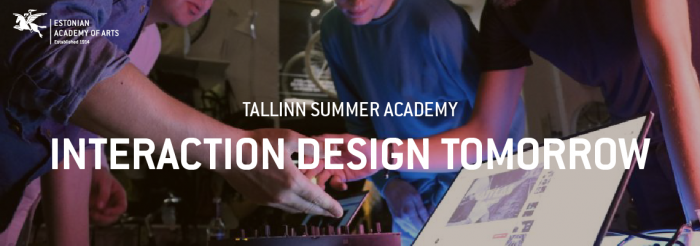
Interaction Design Tomorrow
Dates: 6-10 August 2018
Volume: 40 hours, 3 ECTS
Location: Tallinn, Estonia
Number of participants: max 20
Cost: FREE (Please note that this course is meant for higher education students only)
Registration deadline: 6th of May
Aimed at design students; no programming skills necessary.
In addition to the general required materials, candidates are expected to submit a letter of motivation explaining why they are applying and outlining their experience with Interaction Design so far (max A4). Students are expected to bring their own sketchbooks, markers and laptops.
Over the course of a week you will learn about the foundations, history and possible futures of interaction design within a studio environment. This 5-day hands-on workshop provides a solid foundational knowledge of user experience (UX) design for new practitioners, as well as an in-depth exploration of interaction design for experienced designers. The course gives participants space and guidance to delve deeply into theoretical and practical aspects of interaction design by investigating contemporary issues and proposing design solutions.
Through a series of lectures, films, historic case studies and studio practice, participants will explore the nature and aesthetics of interaction design in the digital and physical space, in individual and group studio practice from ideation and the iterative design process to presentations and critique.
Learning outcomes:
- Learn about design foundations, theory, history and practice
- Understand how to look at problems from social, technological, economic and cultural perspectives
- Practice design research and synthesis
- Learn how to be creative in the digital realm
- Improve your ability to present your design concepts
- Practice working individually and in small teams
More information and link to registration: https://www.artun.ee/summeracademy/interaction-design-tomorrow/

Numbers and Cognition in the Urban Environment
Numbers and Cognition in the Urban Environment
The Anatomy of Couture
Dates: 6-11 August 2018
Volume: 6 days, 3 ECTS
Location: Estonian Academy of Arts
Number of participants: max 22
Cost: FREE (Please note that this course is meant for higher education students only.)
Registration deadline: 6th of May
Students applying for a slot in this workshop are asked to submit a CV and cover letter describing why they wish to participate and whether they have any old article of clothing to bring with them to Estonia. The cover letter should also reveal why they are interested in restoring textiles and haute couture.
Aim of the course:
- bring a disappearing specialized manual skill to Estonia and teach it to Estonian and international students
- restore articles of clothing in the collection of some Estonian museum and thereby contribute to the preservation of an exhibit item with historical value.
Course content:
The course provides practical and theoretical knowledge of how to restore old clothing – selection of fabrics, stitches and seams, treatment of the material, how different materials age, how to care for and restore different fabrics. In the course of the workshop, students will learn about the internal structure of haute couture clothing, allowing them to later create period-specific silhouettes or re-interpretations of them – pattern solutions for textiles, materials. The course will provide knowledge and skills that can be used to get closer to the secrets of high fashion. All of the participants in the course will be able to restore a part of dresses brought in by the lecturer.
The course teaches handicraft skills that have become a rarity, something highly sought-after among professionals. ˇFewer and fewer people practise these skills in a world dominated by modern fashions. Today clothing made 40, 50, even 100 years ago are held in high regard, as they involved the use of original patterns, hand stitching, high-quality tailoring. To this point, the creation of such clothing have remained shrouded in arcane mystery – they seem easy to imitate at first glance but it is impossible to achieve the right effect without knowing what is going on “under the dress.”
The course is mainly meant for fashion design, theatre design, restoration and design students.
More information and link to registration: https://www.artun.ee/summeracademy/the-anatomy-of-couture/
The Anatomy of Couture
Dates: 6-11 August 2018
Volume: 6 days, 3 ECTS
Location: Estonian Academy of Arts
Number of participants: max 22
Cost: FREE (Please note that this course is meant for higher education students only.)
Registration deadline: 6th of May
Students applying for a slot in this workshop are asked to submit a CV and cover letter describing why they wish to participate and whether they have any old article of clothing to bring with them to Estonia. The cover letter should also reveal why they are interested in restoring textiles and haute couture.
Aim of the course:
- bring a disappearing specialized manual skill to Estonia and teach it to Estonian and international students
- restore articles of clothing in the collection of some Estonian museum and thereby contribute to the preservation of an exhibit item with historical value.
Course content:
The course provides practical and theoretical knowledge of how to restore old clothing – selection of fabrics, stitches and seams, treatment of the material, how different materials age, how to care for and restore different fabrics. In the course of the workshop, students will learn about the internal structure of haute couture clothing, allowing them to later create period-specific silhouettes or re-interpretations of them – pattern solutions for textiles, materials. The course will provide knowledge and skills that can be used to get closer to the secrets of high fashion. All of the participants in the course will be able to restore a part of dresses brought in by the lecturer.
The course teaches handicraft skills that have become a rarity, something highly sought-after among professionals. ˇFewer and fewer people practise these skills in a world dominated by modern fashions. Today clothing made 40, 50, even 100 years ago are held in high regard, as they involved the use of original patterns, hand stitching, high-quality tailoring. To this point, the creation of such clothing have remained shrouded in arcane mystery – they seem easy to imitate at first glance but it is impossible to achieve the right effect without knowing what is going on “under the dress.”
The course is mainly meant for fashion design, theatre design, restoration and design students.
More information and link to registration: https://www.artun.ee/summeracademy/the-anatomy-of-couture/

